Complete Solutions to Coulumb'S Law of chapter ELECTRIC CHARGE, FIELD & FLUX of Class 12 book with complete answers and questions
| Class 12 | PHYSICS |
| Chapter | ELECTRIC CHARGE, FIELD & FLUX |
| A2Z | Coulumb'S Law |
| Number Of Questions | 62 |
| Academic Year | 2023-24 |
If a body is charged by rubbing it. Its weight
View SolutionIn a general, metallic ropes are suspended on the carries which take inflammable material. The reason is
View SolutionFour metal conductors having different shapes
1. A sphere 2. Cylindrical
3.Pear 4.Lightning conductor
Are mounted on insulating stands and charged. The one which is best suited to retain the charges for a longer time is
View SolutionWhat is the amount of charge possessed by `1 kg` of electrons
View SolutionA polythene piece rubbed with wool is found to have negative charge of `3.6xx10^(-7)C`. Calculate the number of electrons transferred from wool to polythene. If an electron has a mass `9.1 xx 10^(-31) kg`, find the mass transferred to polythene.
View SolutionThere are two metallic spheres of same radii but one is solid and the other is hollow, then
View SolutionWhen a body is earth connected, electrons from the earth flow into the body. This means the body was `….`
View SolutionA positively charged insulator is brought near(but does not touch) two metallic sphere that are in contact. The metallic spheres are then separated. The sphere which was initially farthest from the insulator will have:
View SolutionSuppose we have large number of identical particles, very small in size. Any of them at `10 cm` separation repel with a force of `3xx10^(-10) N`. If one of them is at `10 cm` from a group of `n` others, how strongly do you expect it to be repelled?
View SolutionAn uncharged metal object `M` is insulated from its surroundings. A positively charged metal sphere `S` is then brought neat to `M`. Which diagram best illustrates the resultant distributions of charge on `S` and `M`
View SolutionFive balls numbered 1,2,3,4,and 5 are suspended using separated threads. The balls (1,2),(2,4) and (4,1) show electrostatic attraction while balls (2,3) and (4,5) show repulsion. Therefore, ball 1 must be
View SolutionA point charge `+q` is placed at a distance `d` from an isolated conducting plane. The field at a point `P` on the other side of plane is
View SolutionIn two cases, two identical conducting sphere are given equal charges, in one case of the same type whereas in another case of opposite type. The distance between the spheres is not large comparing with the diameter. Let `F_(1)` and `F_(2)` be the magnitudes of the force of interaction between the spheres, as shown, then
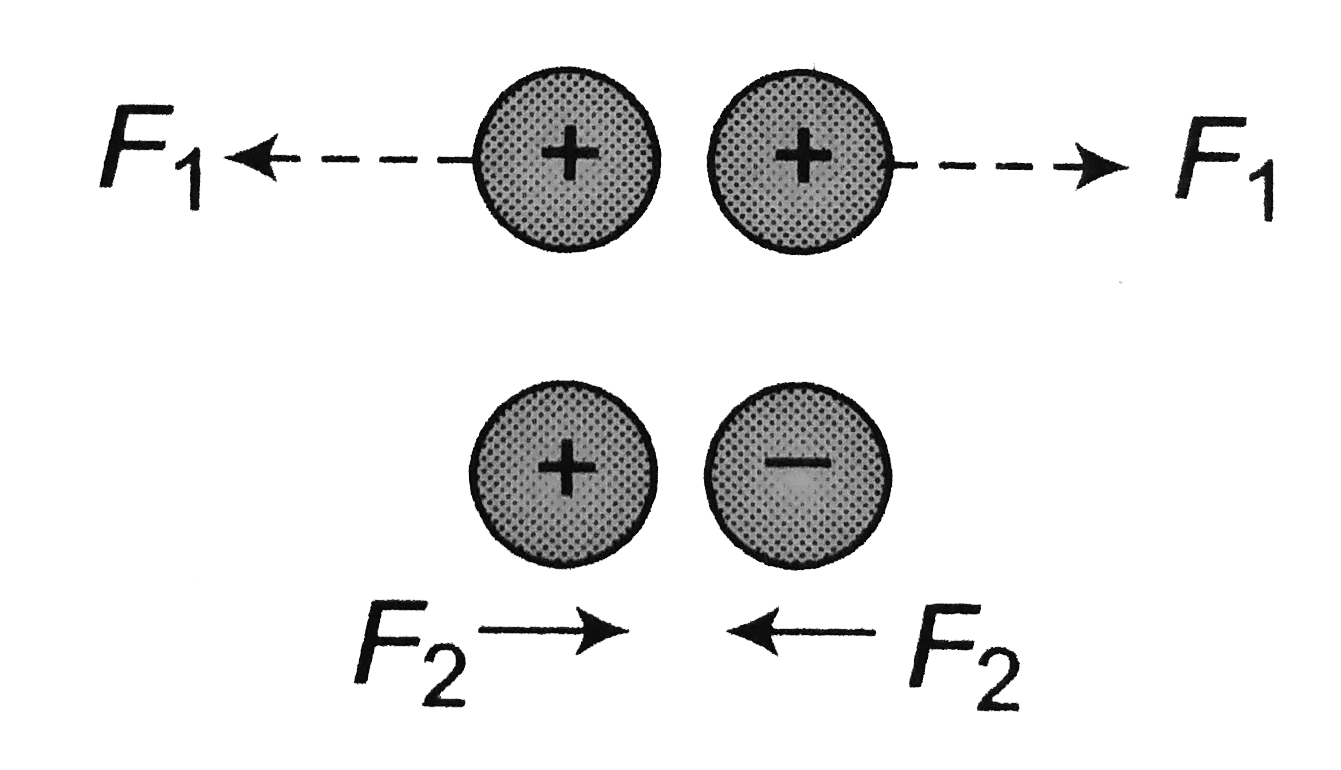
View SolutionThe diagram shows the arrangement of three small uniformly charged spheres, `A,B` and `C`. The arrow indicate the direction of the electrostatic forces acting between the spheres (for example, the left arrow on sphere `A` indicates the electrostatic force on sphere `A` due to sphere `B`). At least two of the spheres are positively charged. Which sphere, if any, could be negatively charged?
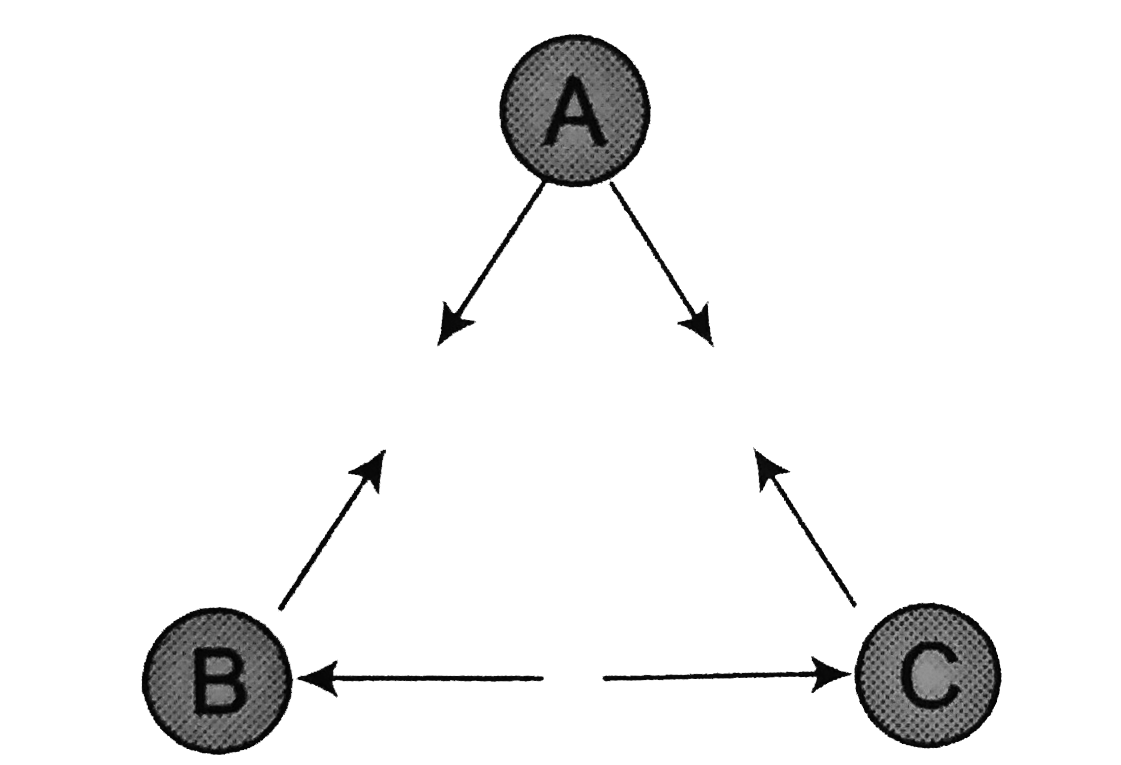
View SolutionThe velocity of an electron at point `A_(1)` is `V_(0)` where cross sectional areas is `A`. The velocity of electron just the end of contraction at point `B`, where cross sectional area is `2A` is `V_(1)`. Find the correct option:
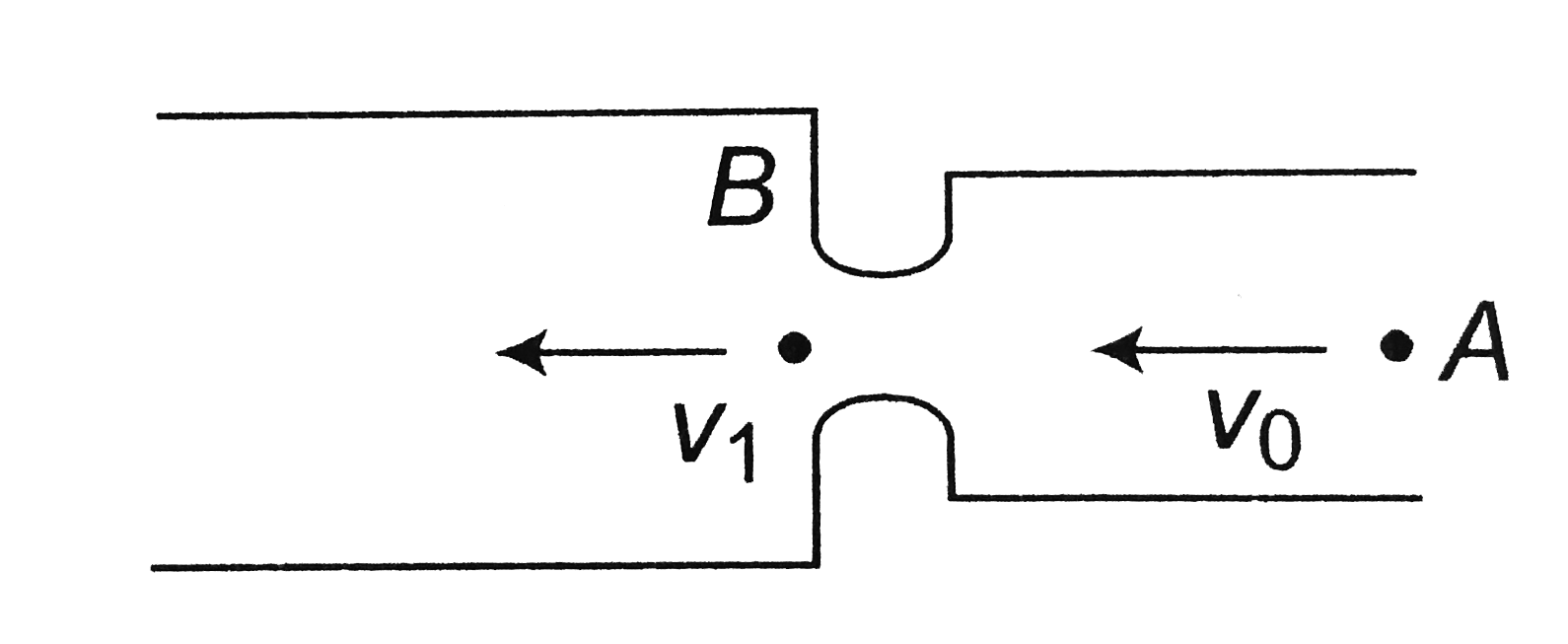
View SolutionA glass rod rubbed with silk is used to charge a gold leaf electroscope and the leaves are observed to diverge. The electroscope thus charged is exposed to `X`-rays for a short period. Then
View SolutionOne metallic sphere `A` is given positive charge whereas another identical metallic sphere `B` of exactly same mass as of `A` is given equal amount of negative charge. Then
View SolutionA charged metallic ball is lowered into an insulated metal can.
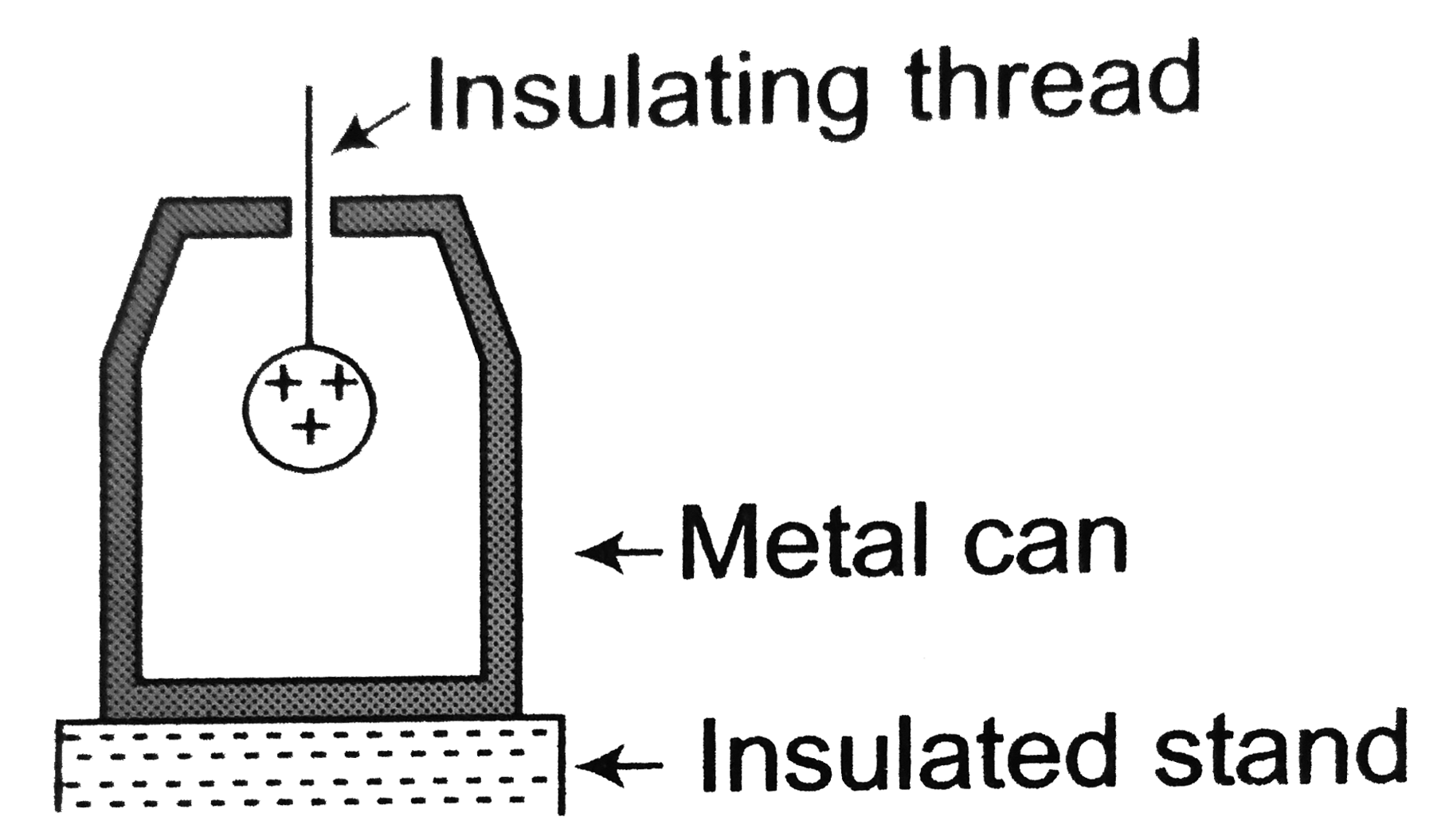
The ball is made to touch bottom of the can. Then it is placed on the disc of electroscope shown below. Final
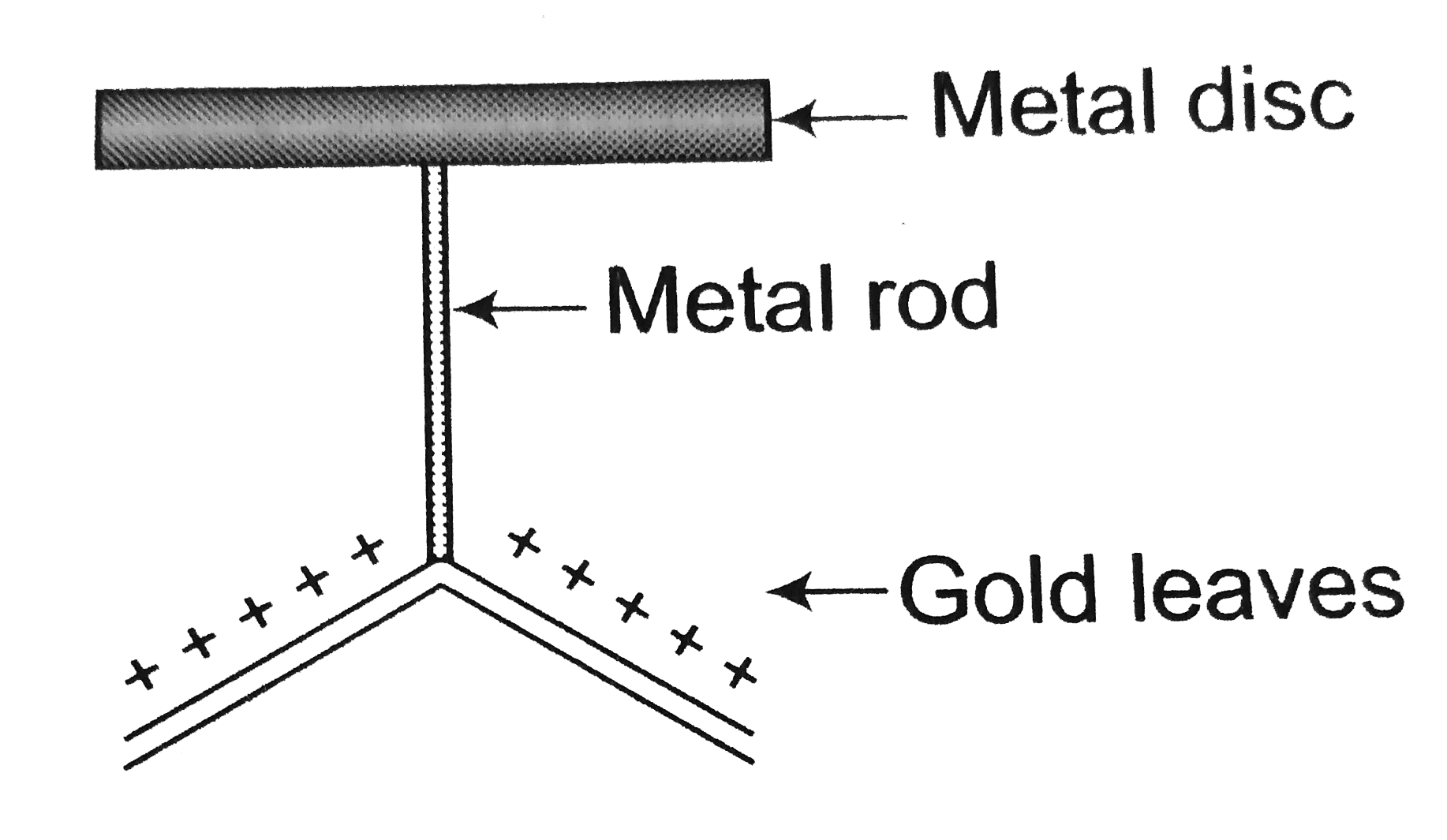
View SolutionAn electroscope is given a positive charge, causing its foil leaves to separate. When an object is brought near the top plate of electroscope, the foils separate even further. We conclude
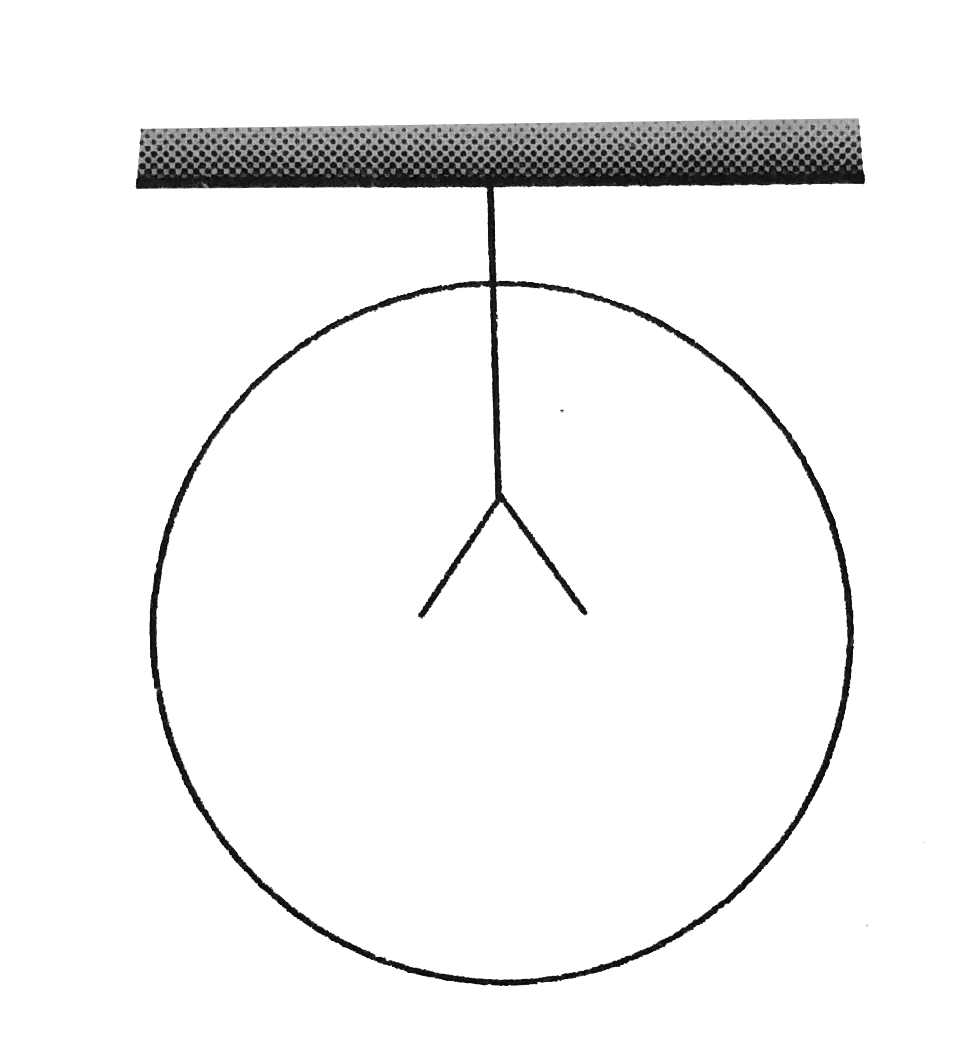
View SolutionGiven are four arrangements of three fixed electric charges. In each arrangement, a point labelled `P` is also identified- test charge, `+q`, is placed at point `P`. All of the charges are of same magnitude `Q`, but they can be either positive or negative as indicated. The charges and point `P` all lie on a straight line. The distances between adjacent items, either between two charges or between a charge and point `P`, all are the same. Compare forces on +q in each case.

View SolutionAn electrically isolated hollow (initially uncharged), conducting sphere has a small positively charged ball suspended by an insulating rod from its inside surface (see diagram).
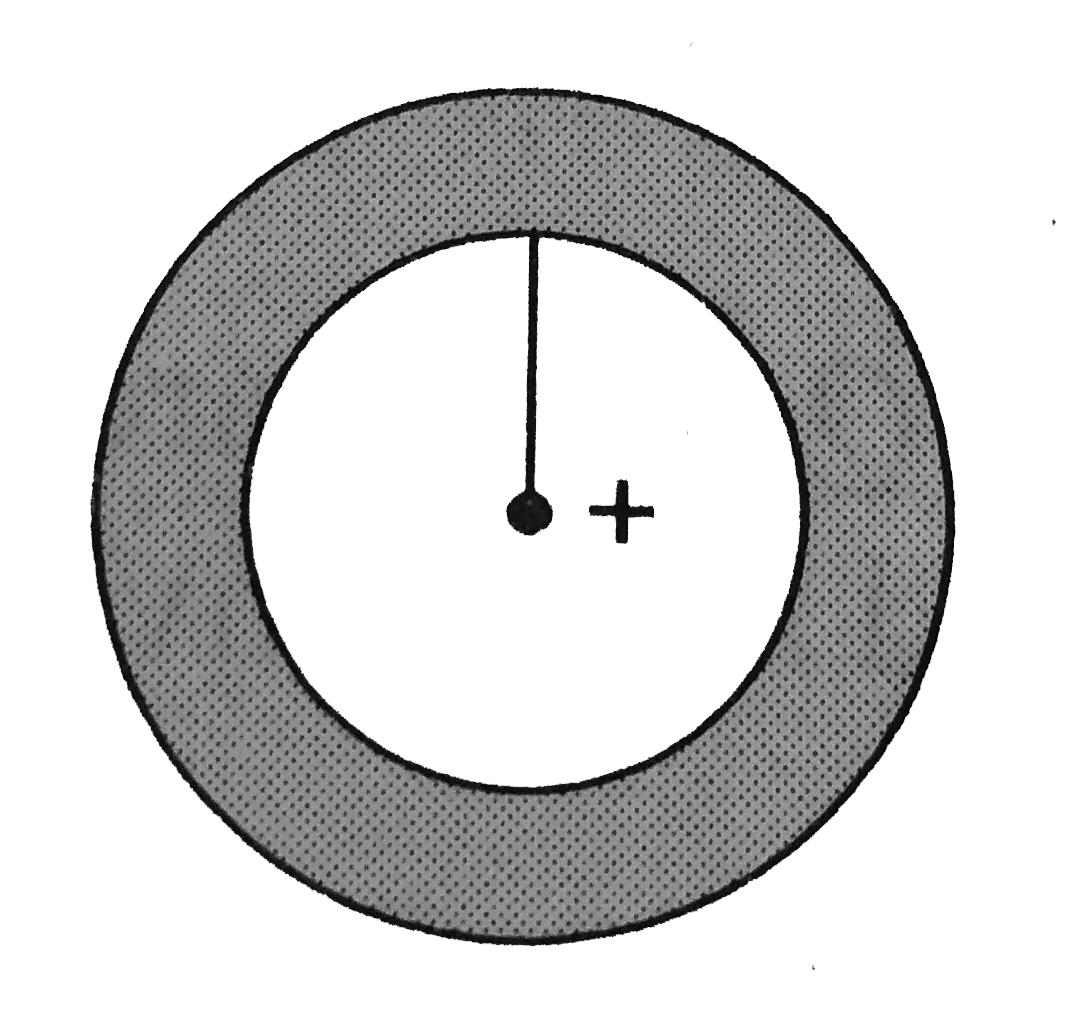
This causes the inner surface of the sphere to become negatively charged. When the ball is centred in the sphere, the electric field outside the conducting sphere is
View SolutionA thin metallic spherical shell contains a charge `Q` on it. A point charge `q` is placed at the center of the shell and another charge `q_(1)` is placed outside it as shown in figure. All the three charges are positive
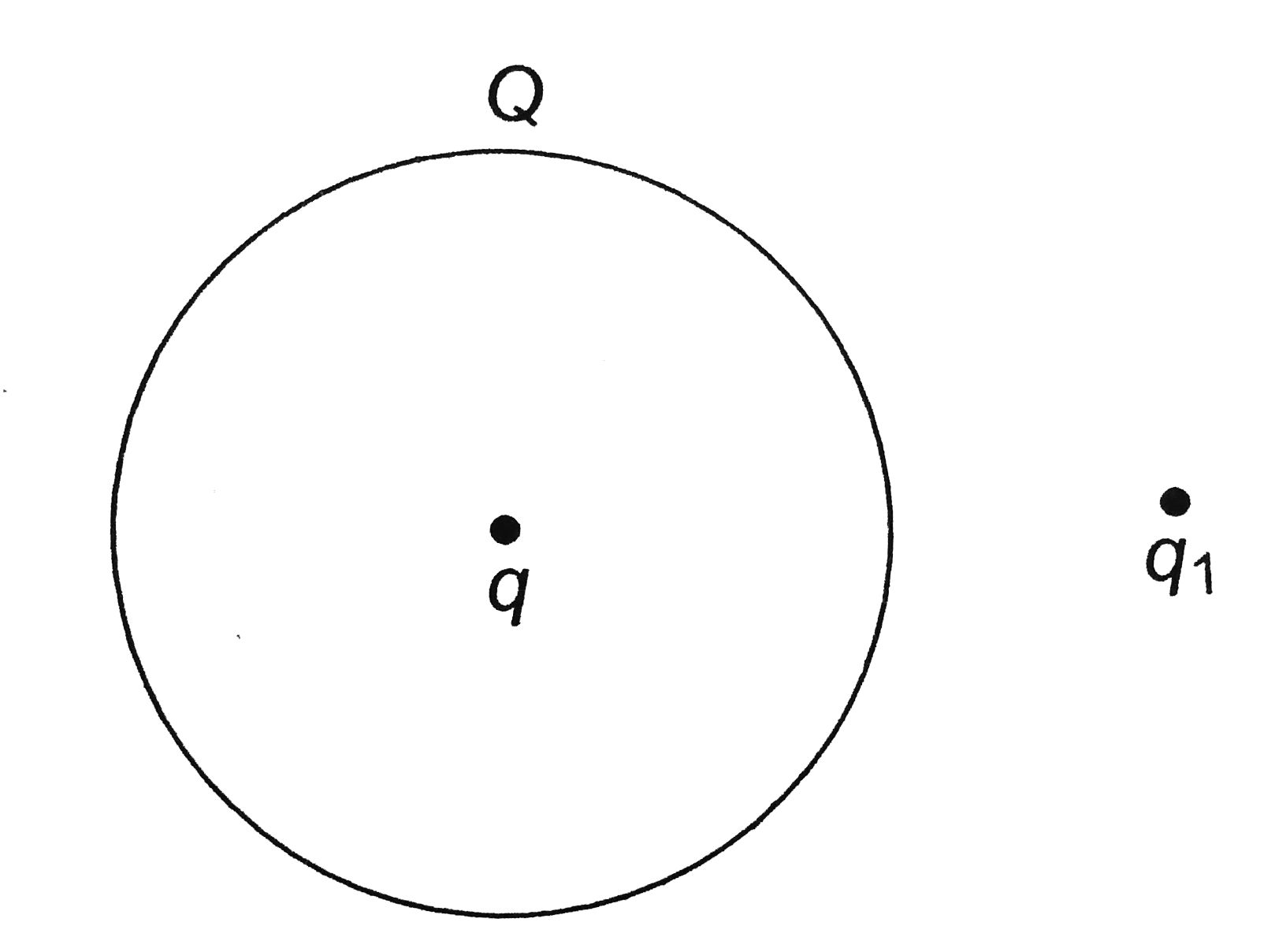
The force on the charge at the centre is
View SolutionA copper sphere of mass `2.0 g` contains about `2xx10^(22)` atoms. The charge on the nucleus of each atom is `29 e (e= "electron charge")`. The mass of an electron is `9.11xx10^(-31) kg`. How much mass will the sphere lose or gain if it is given a charge of `+2 muC`?
View SolutionAssume that each of copper atom has one free electron. Estimate the number of free electrons in `1 mg` of copper. Given that atomic weight of copper `=63.5` and Avogadro number `=6.02xx10^(23)`. What is the charge possessed by these free electrons?
View SolutionEstimate the number of free electrons in `1g` of water and negative charge possessed by them. Given that Avogadro number `=6.02xx10^(23)` and molecular weight of water `= 18`
View SolutionThree point charges are placed at the corner of an equilateral triangle. Assuming only electrostatic forces are acting.
View SolutionTwo identical pendulums A an dB are suspended from the same point. Both are givne positive charge, with A having more charge than B. They diverge and reach equilibrium with the suspension of A and B making angles `theta_(1)` and `theta_(2)` with the vertical respectively.
View SolutionTwo identical small conducting spheres having unequal positive charges `q_1` and `q_2` are separated by a distance r. If they are now made to touch each other and then separated again to the same distance, the electrostatic force between them in this case will be
View SolutionTwo point charges placed at a distance `r` in air experience a certain force. Then the distance at which they will experience the same force in a medium of dielectric constant `K` is
View SolutionTwo copper balls, each weighing `10 g` are kept in air `10 cm` apart. If one electron from every `10^(6)` atoms is transferred from one ball to the other, the coulomb force between them is (atomic weight of copper is `63.5`)
View SolutionWhat is the Coulomb's force between two `alpha`-particles separated by a distance of `3.2xx10^(-15) m`.
View SolutionForce of attraction between two point electric charges placed at a distance `d` in a medium is `F`. What distance apart should these be kept in the same medium, so that force between them becomes `F//3`?
View SolutionTwo identical balls each have a mass of `10 g`. What charges should these balls be given so that their interaction equalizes the force of universal gravitation acting between them? The radii of the balls may be ignored in comparison to distance between them.
View SolutionTwo point charges `+3 muC` and `+8muC` repel each other with a force of `40 N`. If a charge of `-5 muC` is added to each of them, then the force between them will become
View SolutionThe distance between charges `5.0xx10^(-11)C` and `-2.7xx10^(-11)C` is `0.2 m`. The distance at which a third charge should be placed in order that it will not experience any force along the line joining the two charges is
View SolutionCalculate the ratio of electrostatic to gravitational force between two electrons placed at certain distance in air. Given that `m_(e)= 9.1xx10^(-31) kg,e= 1.6xx10^(-19)C` and `G=6.6xx10^(-11)Nm^(-2)`.
View SolutionTwo point charges `+9e` and `+e` are kept `16 cm`. Apart from each other. Where should a third charge `q` be placed between them so that the system is in equilibrium state:
View SolutionTwo spherical conductors B and C having equal radii and cayying equal charges on them repel each other with a force F when kept apart at some distance. A third spherical conductor having same radius as that B but uncharged is brought in contact with B, then brought in contact with C and finally removed away from both. The new force of repulsion between B and C is
View SolutionTwo equally charged, indentical metal spheres `A` and `B` repel each other with a force `F"`. The spheres are kept fixed with a distance `r` between them. A third identical, but uncharged sphere `C` is brought in contact with `A` and The magnitude of the net electric force on `C` is
View SolutionWhat equal charges would have to be placed on earth and moon to neutralize their gravitational force of attraction?
Given that mass of earth `= 10^(25) kg` and mass of moon `= 10^(23) kg`
View SolutionThree charges `4q, Q` and `q` are in a straight line in the position of `0. l//2` and `l` respectively. The resultant force on `q` will be zero, if `Q=`
View SolutionTwo small balls having equal positive charge `Q`(coulomb) on each are suspended by two insulated string of equal length `L` meter, from a hook fixed to a stand. The whole gravity (state of weightlessness). Then the angle between the string and tension in the string is `
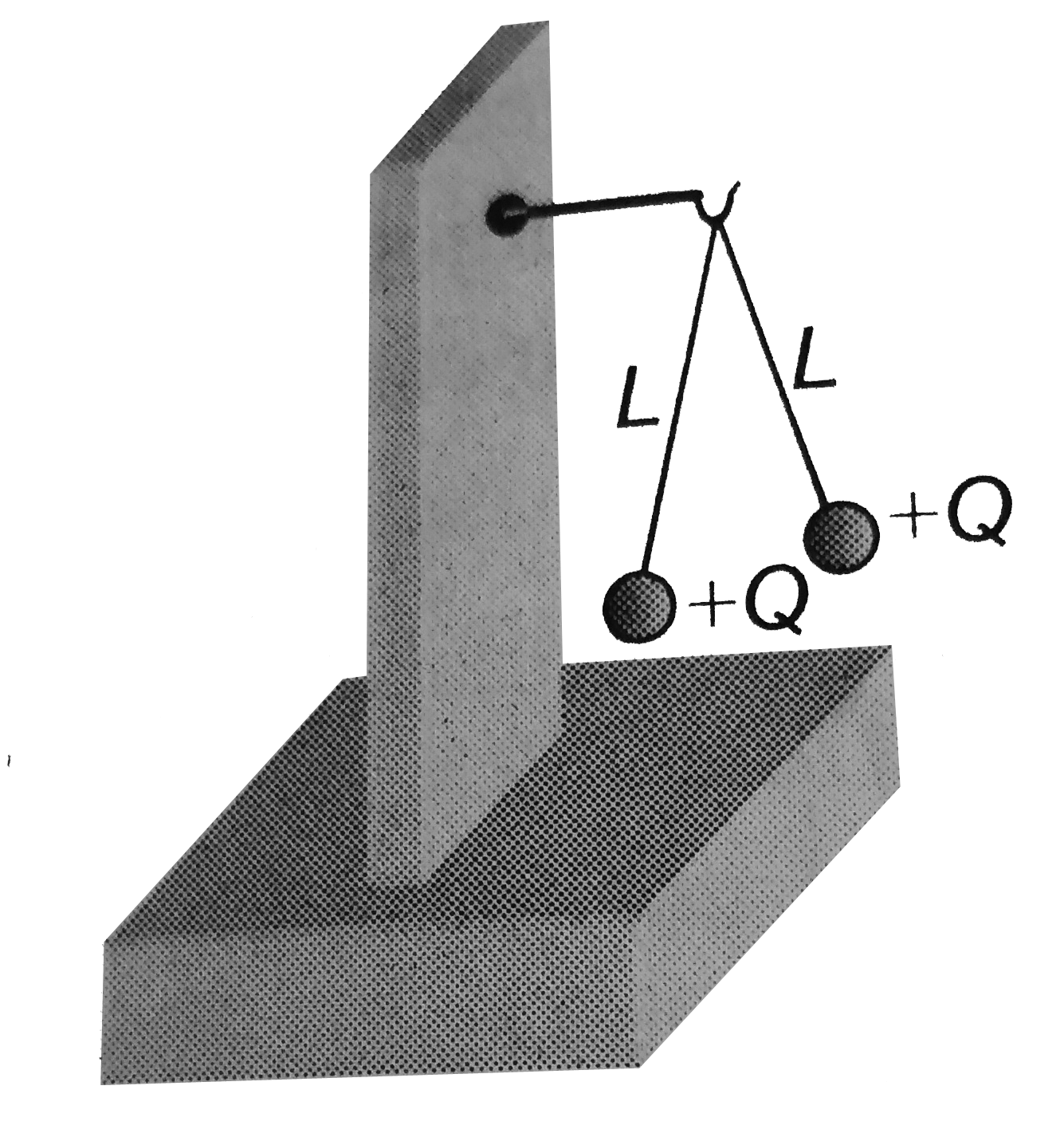
View SolutionTwo similar spheres having `+q` and `-q` and `+4q` charges are kept at a certain distance. The force acts between the two is `F`. If in the middle of two spheres, another similar sphere having `+q` charge is kept,then it experience a force in magnitude and direction as
View SolutionPoint charges `+4q, -q` and `+4q` are kept on the `x`-axis at points `x=0,x=a` and `X=2a` respectively, then
View SolutionTwo identical balls having like charges and placed at a certain distance apart repel each other with a certain force. They are brought in contact and then moved apart to a distance equal to half their initial separation. The force of repulsion between them increases 4.5 times in comparision with the initial value. The ratio of the initial charges of the balls is
View SolutionTwo charges `+4e` and `+e` are at a distance `x` apart. At what distance,a charge `q` must be placed from charge `+e` so that is in equilibrium
View SolutionThree charges `4q, Q` and `q` are in a straight line in the position of `0, l//2` and `l` respectively. The resultant force on `q` will be zero, if `Q=`
View SolutionTwo equal negative charges `-q` are fixed at points `(0, -a)` and `(0,a)` on y-axis. A poistive charge Q is released from rest at point `(2a, 0)` on the x-axis. The charge Q will
View SolutionElectric charges of `1mu C, -1 mu C` and `2mu C` are placed in air at the corners `A,B` and `C` respectively of an equilateral triangle `ABC` having length of each side `10 cm`. The resultant force on the charge at `C` is
View SolutionThree charges each of magnitude `q` are placed at the corners of an equilateral triangle, the electrostatic force on the charge place at the centre is (each side of triangle is `L`)
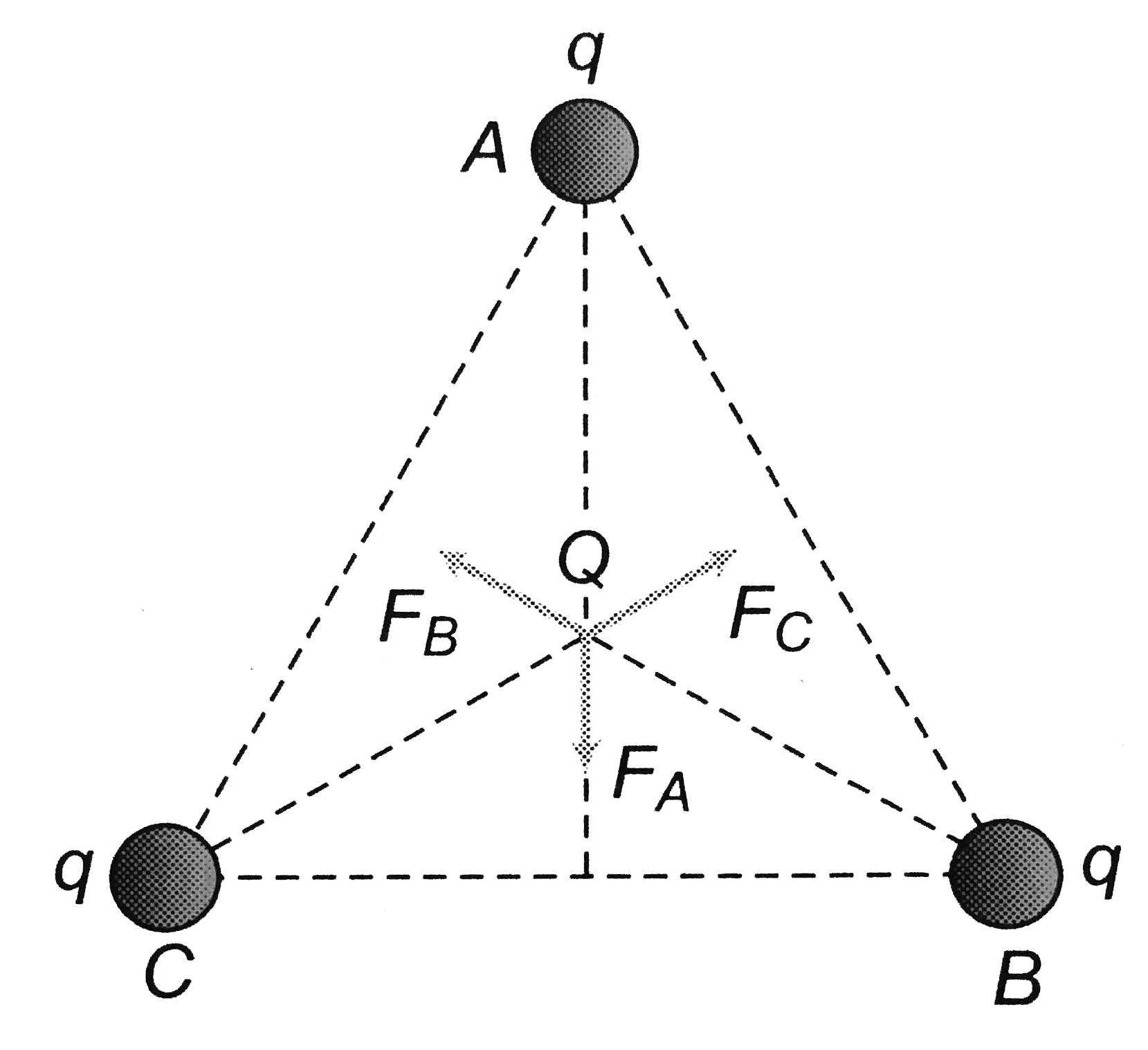
View SolutionEqual charges `q` are placed at the four corners `A,B,C,D`of a square of length `a`. The magnitude of the force on the charge at `B` will be
View SolutionCharges `Q-q, Q,-q` are placed at the corners `A, B, C,D` of a square respectively. If the resultant force on the charge `Q` is zero due to other charges, what is the relation between `Q` and `q`?
View SolutionAn infinite number of charges, each of charge `1 mu C` are placed on the `x`-axis with co-ordinates `x=1,2,4,8….oo` If a charge of `1C` is kept at the origin, then what is the net force action on `1C` charge
View SolutionA charge q is placed at the centre of the line joining two equal charges Q. The system of the three charges will be in equilibrium if q is equal to:
View SolutionFour point `+ve` charges of same magnitude`(Q)` are placed at four corners of a rigid square frame as shown in figure. The plane of the frame is perpendicular to `z`-axis. If a `-ve` point charge is placed at a distance `z` away from the above frame `(z lt lt L)` then
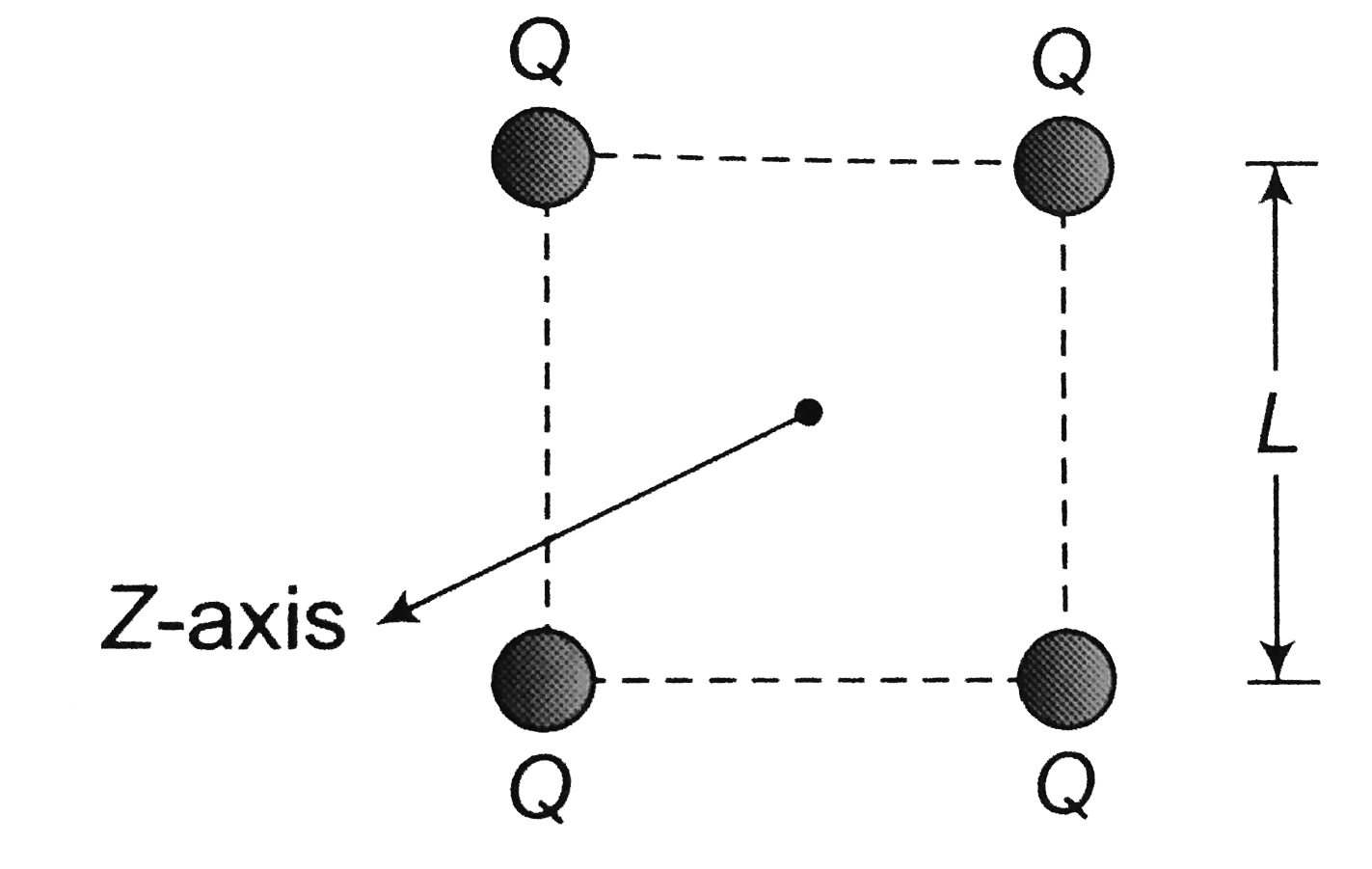
View SolutionIn the given figure two tiny conducting balls of identical mass `m` and identical charge `q` hang from non-conducting threads of equal length `L`. Assume that `theta` is so small that than `theta~~ sin theta`, then for equilibrium `x` is equal to
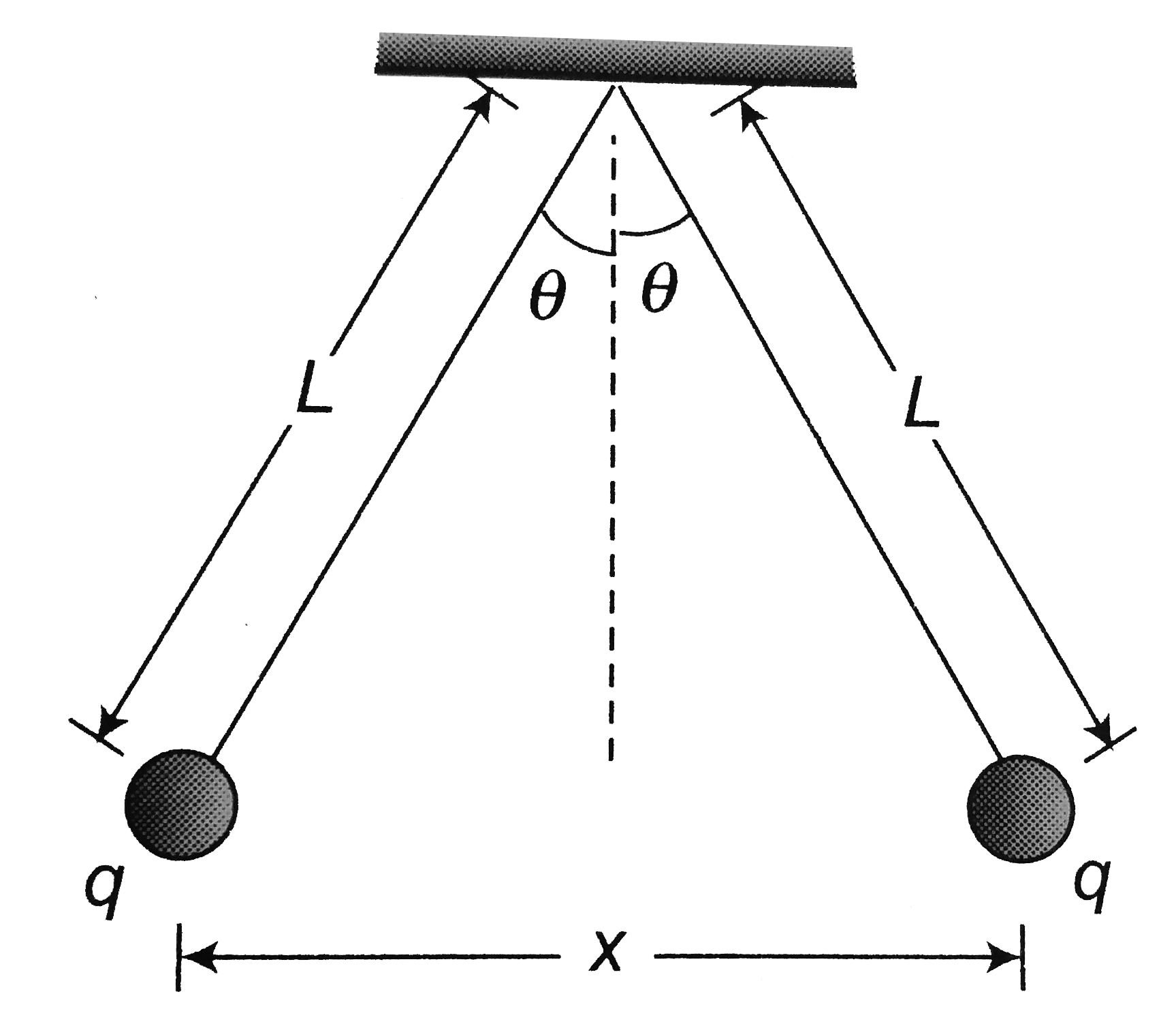
View SolutionThree charges `+q, +2q` and `4q` are connected by strings as shown in the figure.What is ratio of tensions in the strings `AB` and `BC`

View SolutionFour charges are arranged at the corners of a square `ABCD`, as shown in the adjoining figure, The force on a positive charge kept at the centre `O` is
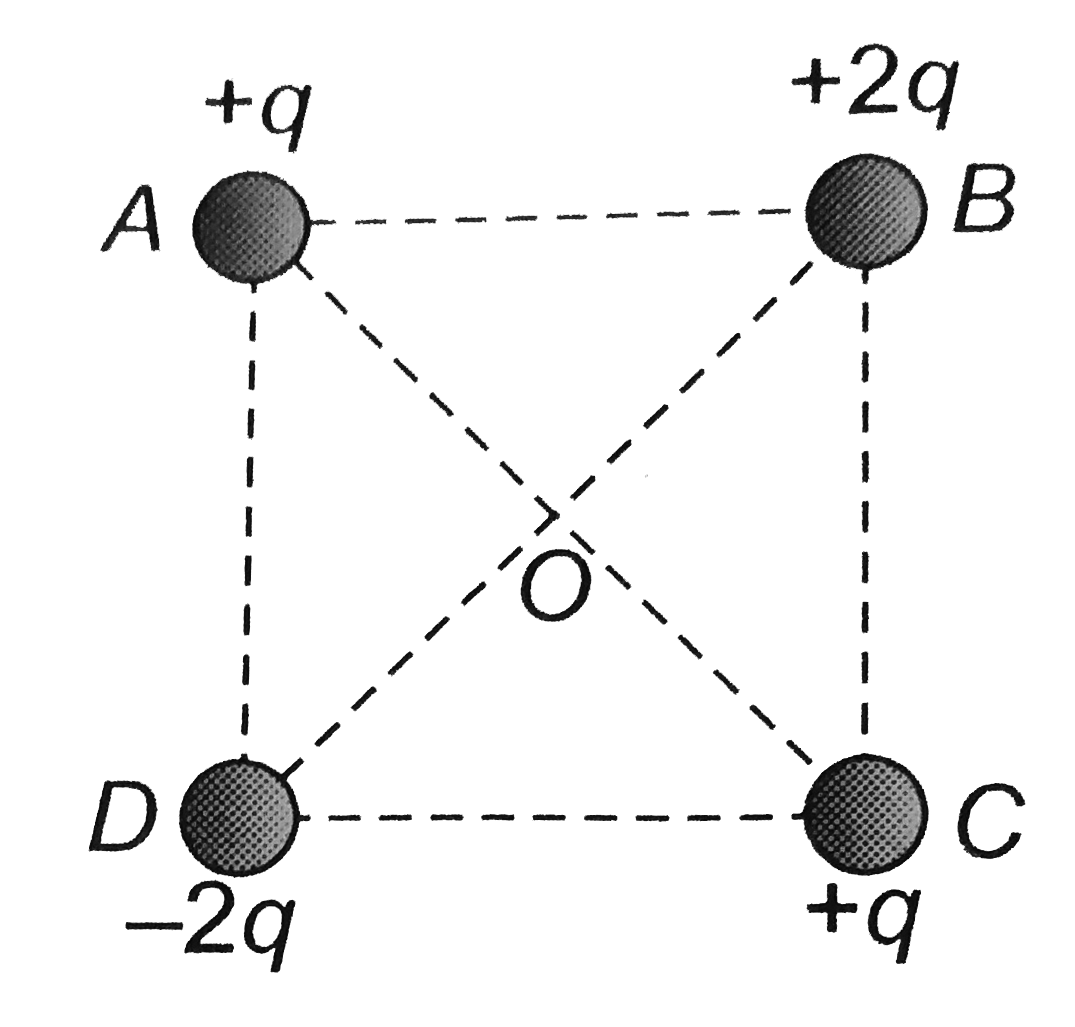
View SolutionThree charges are placed at the vertices of an equilateral trianlge of side `a` as shown in the following figure. The force experienced by the charge placed at the vertex `A` in a direction normal to `BC` is

View SolutionTwo small spherical balls each carrying a charge `Q= 10 mu C`( 10 micro=coulomb) are suspended by two insulating threads of equal lengths `1 cm` each, from a point fixed in the ceiling. It is found that in equilibrium threads are sepreated by an angle `60^(@)` between them, as shown in figure. What is the tension in the threads
(Given `(1)/(4piepsilon_(0))= 9xx10^(9)Nm//C^(2)` )
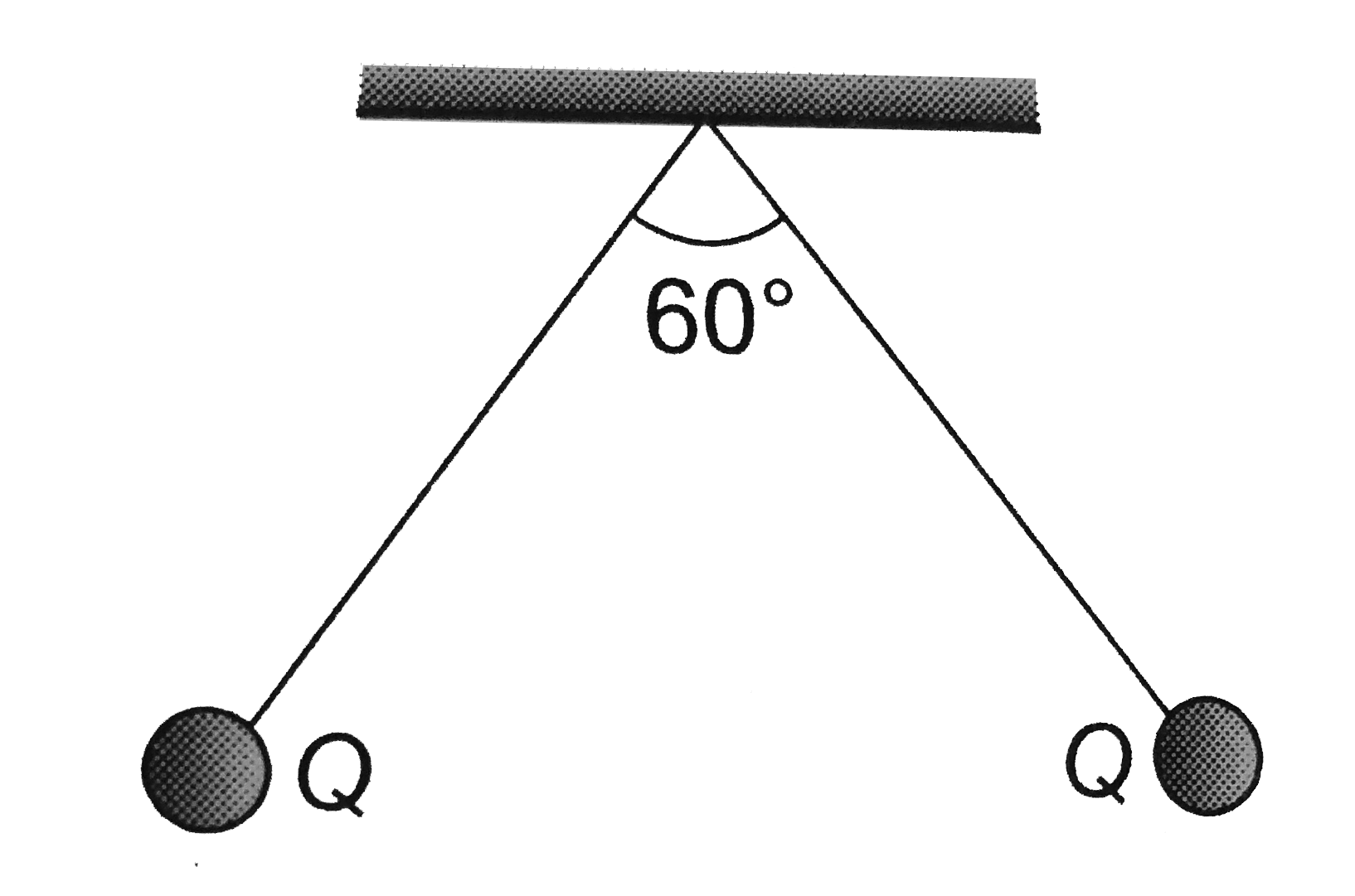
View SolutionFour charges equal to `-Q` are placed at the four corners of a square and a charge `q` is at its centre, If the system is in equilibrium the value of `q` si
View SolutionThe distance between two equal balls having unlike charges is `2cm`. The radii of the balls are much less than the distance between them. The balls attract each other with a force of `36xx10^(-5)`N. After the ball have been connected by a wire and latter has been removed, the balls repel each other with a force of `20.25xx10^(-5)`N. Determine the original charges on the balls
View Solution
Coulumb'S Law questions and complete solutions for chapter ELECTRIC CHARGE, FIELD & FLUX of A2Z PHYSICS (HINGLISH) of Class 12